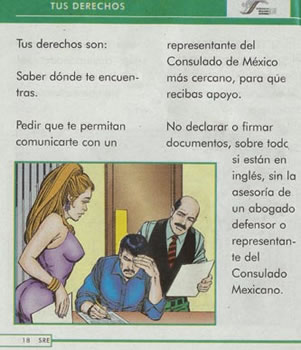Sueño Americano

"Sueño Americano" means "American Dream." Maybe it should include "Sueño Canadiense" (Canadian dream), since the dream really amounts to heading north to make money and / or escape a bad situation at home. In Acapulco, it is very common to meet locals that have gone to the U.S. or Canada to work (both legally and illegally). It also seems a large number of the locals you meet have vague plans to do so themselves one day.
Immigration Facts
The myth in the US is that everyone in Mexico would like to be working in the US, and, of course, that is far from true. In fact, most legal visitors to the US from Mexico arrive because they have friends, family, study programs, special skills or abilities, and other legitimate reasons to enter. This fact is not articulated in the horrendous statistics thrown about in the American media. Even more to the point, the press finds it more sensational to make Mexican immigration sound like an uncontrollable plague of locusts. In truth, even those who cross illegally into the US and Canada, eventually return home. Nevertheless, the long border and the proximity of Mexico to the US invariably spawns illegal migration -- in both directions.
- In a 2002 survey, of the 32.5 million foreign-born U.S. residents, some 30 percent were of Mexican origin.
- Mexico is the largest source of undocumented immigrants. There were an estimated 9.3 million undocumented immigrants in the United States as of March 2002. More than one in every two Mexican immigrants is an illegal, compared with one in about six for other foreign born residents.
- Mexicans represent 20% of the legal immigrants living in the US, or one in five.
Source: http://www.migrationinformation.org
Although publications like the CIA World Factbook state a 2003 Mexican unemployment rate of 3.3%, the methodology used is suspect. Anyone who has spent a day or two in Mexico can see that it is much higher than that. They also understate underemployment at 25%, which is undoubtedly close to double that percentage, or more.
It is also not difficult to understand why the private sector in the US looks the other way. Private businesses
do quite well with a source of low-cost labor. Much of the cost is passed along to taxpayers in the form of lost income and social security taxes and public welfare services.
The US dollars immigrants send home contribute ultimately to help the government service its large foreign debt, estimated at $160 billion (about 20% of GDP). Remittances from Mexican workers in the US -- both legal and illegal -- are Mexico's second largest source of foreign exchange (after petroleum exports). In the financial crisis of 2008-2010, the drop in illegal immigration from Mexico (and the consequential reduction of the inflow of dollars to the economy) contributed to financial austerity at the governmental level. Of course, other factors, like the drop in demand for petroleum, also weighed heavily in creating the adverse situation. Worse still, the very rich in Mexico -- mainly top-level entrepreneurs and politicians -- fled the peso, buying assets denominated in dollars, with the result that the peso depreciated substantially.
Nevertheless, the Mexican government and economy benefits greatly from the export of local labor -- both legal and illegal -- to the US. A 1990 study found that Mexico’s Gross National Product (GNP) rose by between $2.69 and $3.17 for every dollar Mexican households received from workers in the United States. In 2003 alone, Mexican immigrants living in the US sent home some $11 billion.
During the previous Bush administration, the government in Mexico published literature about how to cross the border safely and responsibly, even if illegally. The page to the right contains advice on what to do in case of capture: "Your Rights: To know where you are being held. To ask that you are allowed to communicate with a representative of the nearest Mexican Consulate in order to receive help. Don't make statements on the record or sign any documents, especially if they are in English, without access to a defense lawyer or a representative
of the Mexican Consulate." In Mexico, people that cross illegally are known as mojados (roughly, "wetbacks") because many literally get wet crossing the Rio Grande.

Mexican Dream
The press has not given much attention to the "Mexican Dream," which describes the growing number of Americans and Canadians who move to Mexico. Many come because their pensions do not give them a dignified existence in the US, but in Mexico one can live comfortably. According to one estimate, the number of US nationals living in Mexico is around 500,000. Another is more conservative, placing it at 150,000. The truth is probably somewhere in the middle. Many American expatriates apply for formal residence (temporary or permanent), which is readily available for pensioners or investors who can live without taking employment from locals. Many just come and go with 6-month tourist cards, which are easy to arrange at the time of entry.
Most US expatriates in Mexico have settled in Baja California, Guadalajara (especially the temperate Lago Chapala area), Mexico City and environs(like San Miguel de Allende). On the Pacific coast, many more expats live in Puerto Vallarta and Los Cabos than in Acapulco. Acapulco has attracted its share of the "upper crust." A large proportion of the multi-million dollar villas in Acapulco's luxurious Las Brisas area are held in special trust arrangements (called "fidecomisos") for wealthy Americans and Canadians.
So, if it is true that Mexicans have made inroads in Texas, New Mexico, Arizona, and California, the gringos are moving to Baja California and some of Mexico's best colonial and beach areas. This is something you can expect from peaceful, neighboring countries. These trends seem to work in both directions.
